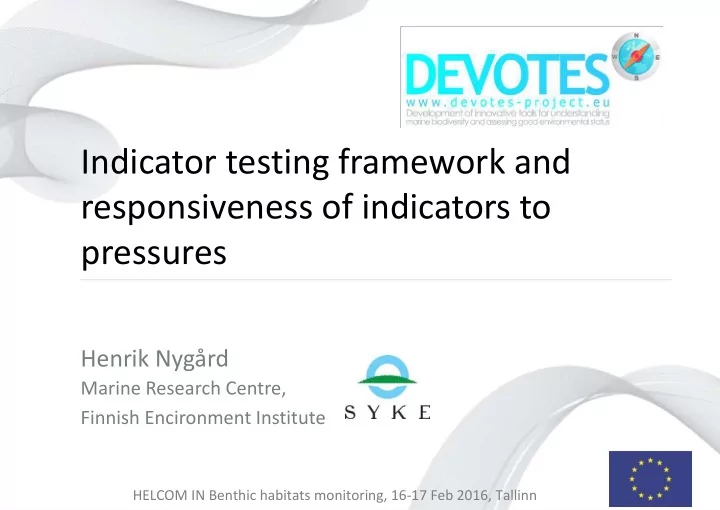

Indicator testing framework and responsiveness of indicators to pressures Henrik Nygård Marine Research Centre, Finnish Encironment Institute HELCOM IN Benthic habitats monitoring, 16-17 Feb 2016, Tallinn
Background • DEVOtool collected information on ~550 indicators available for marine biodiversity assessments • A preliminary evaluation revealed that several of these lacked essential properties to be used for MSFD assessments • An objective framework to test the suitability of indicators under a standardized approach Krause-Jensen et al. 2015 (DEVOTES Deliverable 3-2), Queiros et al. subm. 2
Indicator quality criteria 1. Scientific basis 2. Ecosystem relevance 3. Responsiveness to pressure 4. Possibility to set targets within the indicator response 5. Precautionary capacity/early warning/anticipatory capability 6. Quality of sampling method: measureable, accurate and precise outputs 7. Cost-effective implementation 8. Part of an existing or current ongoing monitoring or data 3
Evaluation steps ES1 states the null hypothesis associated with the IQ tested ES2 defines which assessment approach should be employed to test the hypothesis, i.e. qualitative or quantitative, and is conditional to its nature ES3 states the type of evidence required to undertake the assessment ES4 defines the methodology (e.g. type of statistical analysis or otherwise) undertaken to test the hypothesis considered and its outcome ES5 states the quality score for the particular IQ tested given ES4 4
Indicator testing framework 5 Queiros et al. subm.
Example IQ 4: Possibility to set targets IQ4 - ES1: a clear and unambiguous target cannot be defined for the indicator within a range with defined units of measurement IQ4 – ES2: both expert judgement/ qualitative approach and a quantitative approach can be adequate, depending on the indicator. IQ4 – ES3: information about the range of natural variability of the system is required, against which the target level is defined. IQ4 – ES4: the method of analysis must consider the impact/influence of natural variability (if any) on the response of the indicator (identify, estimate and diagnose). The analysis must be appropriate for the type of data at hand (qualitative c.f. quantitative). IQ4 – ES5: the indicator scores 1 if a clear and unambiguous target can be defined with clear units of measurement, and 0 if: i) a clear and unambiguous target cannot be defined; or ii) there is not sufficient background information to define the range of the natural variability of the system (i.e. habitat and scale) within which the indicator is to be implemented. The three-way scoring system could be applied to IQ4. 6 Queiros et al. subm.
Indicators vs environmental status • Indicators reflect the environmental status but there is always some uncertainty • Signal detection theory provide a method to quantify the uncertainty, and can assist in setting indicator threshold values True environmental status Bad Good True positive False positive Bad ” hits ” ” false alarm ” Status from indicator Good False negative True negative ”miss” 7
Responsiveness to pressures Swets et al. 2000 8
ROC curves provide a visl evaluation of the output Specificity Sensitivity Swets et al. 2000 9
Needed to test the responsiveness of an indicator to a pressure: • ”Gold standard ” surrogate or best estimate of the environmental state • Indicator values To take into account when setting threshold level for the indicator: • Prevalence of conditions • Consequences of being wrong 10 Swets et al. 2000
11 Chuseve et al. 2016
This project has received funding from the European Union’s Seventh Framework Programme for research, technological development and demonstration under the grant agreement nº 308392 Grant agreement nº 308392 www.devotes-project.eu HELCOM IN Benthic habitats monitoring, 16-17 Feb 2016, Tallinn
Recommend
More recommend